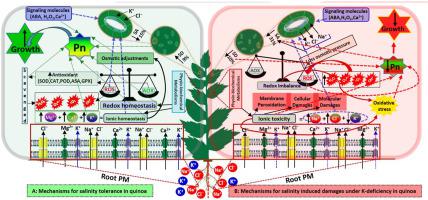Plant Physiology and Biochemistry ( IF 6.1 ) Pub Date : 2020-11-26 , DOI: 10.1016/j.plaphy.2020.11.043 Muhammad Waqas , Chen Yaning , Hassan Iqbal , Muhammad Shareef , Hafeez ur Rehman , Hafiz Muhammad Bilal

|
Quinoa emerged as an ideal food security crop due to its exceptional nutritive profile and stress enduring potential and also deemed as model plant to study the salt-tolerance mechanisms. However to fill the research gaps of this imperative crop, the present work aimed to study the effect of potassium (K) deficiency either separately or in combination with salinity. First, we investigated the stomatal and physiological based variations in quinoa growth under salinity and K, then series of analytical tools were used with model approach to interpret the stomatal aperture (SA) and photosynthesis (Pn) changes. Results revealed that quinoa efficiently deployed antioxidants to scavenge the excessive reactive oxygen species (ROS), had high uptake and retention of K+, Ca2+, Mg2+ with Cl⁻ as charge balancing ion, increased stomata density (SD) and declined the SA to maintain the Pn which resulted the improved growth under salinity. Whereas, K-deficiency caused the stunted growth more severally under salinity due to disruption in ionic homeostasis, excessive ROS production elicited the oxidative damages, SD and SA reduced and ultimately declined in Pn. Our best fitted regression model explored that dependent variables like Pn and SA changed according to theirs signified explanatory variables with quantification per unit based as stomatal conductance (Gs, 51), SD (0.05), ROS (−0.79) and K+ (0.08), Cl⁻ (0.34) and Na+ (- 0.52) respectively. Overall, moderate salinity promoted the quinoa growth, while K-deficiency particularly with salinity reduced the quinoa performance by affecting stomatal and non-stomatal factors.
中文翻译:

藜麦盐分和钾缺乏的协同效应:与气孔模式,离子关系和氧化代谢相关
藜麦因其出色的营养特性和持久的耐力而成为理想的粮食安全作物,并且被认为是研究耐盐机理的模型植物。然而,为了填补这一必要作物的研究空白,本研究旨在单独或结合盐分研究钾(K)缺乏症的影响。首先,我们研究了盐度和K下藜麦生长的气孔和生理变化,然后使用一系列分析工具和模型方法来解释气孔孔径(SA)和光合作用(Pn)的变化。结果表明,藜麦有效地部署了抗氧化剂,以清除过量的活性氧(ROS),具有较高的K +,Ca 2 +,Mg 2+吸收和保留能力。以Cl +为电荷平衡离子,增加了气孔密度(SD)并降低了SA以维持Pn,这导致了盐度下生长的改善。钾缺乏导致盐度下由于离子动态平衡的破坏而停滞生长,而过量的ROS产生引起氧化损伤,SD和SA降低,最终Pn下降。我们的最佳拟合回归模型探讨了Pn和SA等因变量根据其有意义的解释变量而发生了变化,并以气孔导度(Gs,51),SD(0.05),ROS(-0.79)和K +(0.08)为单位量化,Cl⁻(0.34)和Na +(-0.52)。总体而言,适度盐度促进了藜麦的生长,而钾缺乏(特别是盐分缺乏)通过影响气孔和非气孔因素而降低了藜麦的性能。











































 京公网安备 11010802027423号
京公网安备 11010802027423号